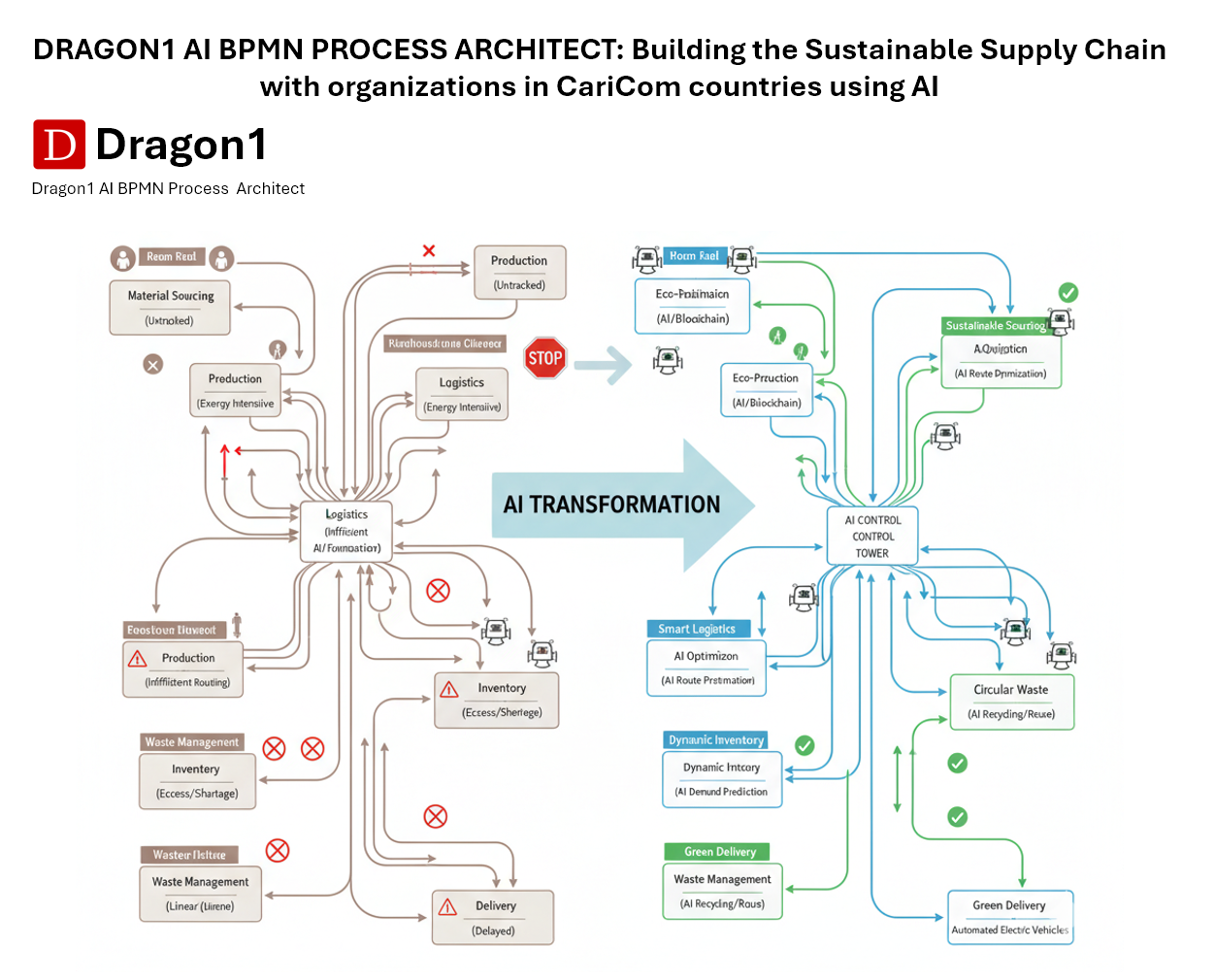BPMN Process Modeling: Navigating Modern Challenges with AI | [Your Software Company Name]
AI Redesign of the Future: Why Every CariCom Organization Needs AI BPMN Process Modeling Now More Than Ever
In an era defined by relentless change, organizations across the globe face an unprecedented array of challenges and opportunities. From the transformative power of Artificial Intelligence (AI) and the imperative of digital transformation to the urgent demands of climate change and the intricate complexities of global food quality, the very fabric of business and governance is being reshaped. In this dynamic landscape, the ability to clearly understand, meticulously design, and rapidly adapt operational processes is not just an advantage—it's a fundamental requirement for survival and success.

The New Process: AI-Driven Sustainable Supply Chain Optimization
Today's Unprecedented Challenges Demand Process Clarity
The challenges confronting organizations today are multifaceted and interconnected:
- Artificial Intelligence (AI) Integration: AI is revolutionizing how we work, automating tasks, predicting trends, and enabling new forms of decision-making. However, successfully embedding AI into existing operations requires a deep understanding of current workflows to identify optimal integration points, manage data flows, and mitigate risks. Without a clear process map, AI implementation can lead to unforeseen bottlenecks or simply automate inefficiencies.
- Accelerated Digital Transformation: The race to digitalize operations continues unabated. Cloud computing, IoT, and advanced analytics demand streamlined processes that can leverage these technologies effectively. Outdated, paper-based, or fragmented processes become critical impediments, hindering agility and scalability.
- Climate Change & Sustainability Mandates: Environmental responsibility is no longer optional. Organizations must re-evaluate their entire value chain to minimize carbon footprints, manage resource consumption, and comply with evolving sustainability regulations. This often necessitates fundamental shifts in how products are made, services are delivered, and supply chains are managed – all rooted in process redesign.
- Global Food Quality & Supply Chain Resilience: The global food industry faces immense pressure, from ensuring safety and quality across complex supply chains to adapting to climate shocks and geopolitical instability. Traceability, compliance, and rapid response mechanisms depend entirely on robust and well-defined processes.
- Evolving Regulatory Landscapes: Data privacy (GDPR, CCPA), industry-specific compliance, and cybersecurity threats continually introduce new requirements, demanding that processes are not only efficient but also secure and auditable.
- Remote Work & Distributed Teams: The shift to remote and hybrid work models has underscored the need for processes that are transparent, accessible, and executable across geographically dispersed teams, often requiring digital-first approaches.
The Imperative for Business Process Modeling (BPMN)
In this environment, every company will need to redesign its processes. This isn't just about minor tweaks; it's about fundamental re-architecture. This is precisely where BPMN (Business Process Model and Notation) emerges as an indispensable tool.
BPMN provides a globally recognized, standardized graphical notation for specifying business processes in a business process diagram. It offers:
- Universal Understanding: A common language that bridges the gap between technical teams and business stakeholders, ensuring everyone comprehends how work gets done.
- Clarity & Documentation: A clear, unambiguous visual representation of current ("as-is") processes and proposed ("to-be") processes, identifying redundancies, inefficiencies, and compliance gaps.
- Optimization & Innovation: A powerful framework for simulating, analyzing, and optimizing processes for efficiency, cost reduction, quality improvement, and resilience. It allows organizations to envision and design innovative workflows for AI integration or new digital services.
- Agility & Adaptability: The ability to quickly model and re-model processes enables organizations to respond swiftly to market changes, new regulations, or disruptive technologies.
- Foundation for Automation: A well-modeled BPMN diagram serves as the blueprint for process automation, whether through Robotic Process Automation (RPA), workflow engines, or AI-driven systems.
Introducing the AI BPMN Process Architect by Dragon1
At Dragon1, we understand these challenges. Our new AI BPMN Process Architect tool empowers organizations to confront these complexities head-on. Leveraging advanced AI capabilities, our platform accelerates the modeling process, suggests optimizations, and helps predict the impact of process changes. It's designed to streamline the analysis, design, and implementation of new processes, enabling you to:
- Rapidly map and analyze existing workflows.
- Intuitively design future-proof processes for AI integration and digital transformation.
- Collaborate seamlessly across teams and departments.
- Ensure compliance and build resilient, sustainable operations.